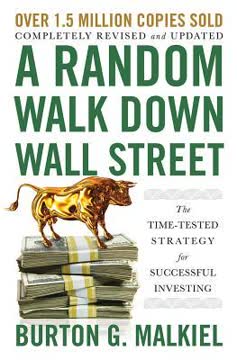Key Takeaways
1. Understanding Stocks: The Building Blocks of Wall Street
"A share of stock is a piece of a company."
Ownership and value. Stocks represent partial ownership in a company, entitling shareholders to a portion of the company's profits and assets. The value of a stock is determined by the company's earnings, dividends, and overall financial health, as well as market supply and demand.
Stock pricing factors:
- Earnings per share (EPS)
- Price-to-earnings (P/E) ratio
- Dividend yield
- Company growth prospects
- Industry trends
- Economic conditions
Understanding these fundamentals is crucial for making informed investment decisions and navigating the stock market effectively.
2. The Evolution and Mechanics of Stock Exchanges
"Wall Street is a street in New York City, pointing straight from Franklin D. Roosevelt Drive near the East River to the old Trinity Church. But this is not the Wall Street people refer to when they ask, 'How does Wall Street work?' or 'What does Wall Street say?' That Wall Street is a marketplace."
Historical development. From its humble beginnings as a dirt path in New Amsterdam to the global financial hub it is today, Wall Street has undergone a remarkable transformation. The New York Stock Exchange (NYSE), founded in 1792, remains the world's largest stock exchange by market capitalization.
Modern trading mechanics:
- Electronic trading platforms
- High-frequency trading algorithms
- Market makers and specialists
- Order types (market, limit, stop)
- Primary and secondary markets
The shift from open outcry trading floors to digital platforms has revolutionized the speed and efficiency of stock exchanges, making markets more accessible to individual investors while introducing new challenges and opportunities.
3. Fundamental Analysis: Decoding Company Financials
"The company with the best-performing stock over the long run—ten or twenty years—almost always has a superior record of earnings, dividends, and improved financial condition."
Key financial statements. Fundamental analysis involves scrutinizing a company's financial statements to assess its health and growth potential. The three primary financial statements are:
- Income Statement: Shows revenues, expenses, and profits
- Balance Sheet: Outlines assets, liabilities, and shareholders' equity
- Cash Flow Statement: Details cash inflows and outflows
Important metrics:
- Return on Equity (ROE)
- Debt-to-Equity ratio
- Profit margins
- Revenue growth
- Free cash flow
By analyzing these statements and metrics, investors can gain insights into a company's profitability, efficiency, and financial stability, helping them make more informed investment decisions.
4. Technical Analysis: Reading Market Sentiment
"Technical Analysis refers to the study of all factors related to the actual supply of and demand for stocks."
Chart patterns and indicators. Technical analysts use historical price and volume data to identify patterns and trends that may predict future market behavior. Common tools include:
- Candlestick charts
- Moving averages
- Relative Strength Index (RSI)
- Fibonacci retracements
- Support and resistance levels
Trading signals. These patterns and indicators can generate buy or sell signals, helping traders time their entries and exits. However, it's important to note that technical analysis is not infallible and should be used in conjunction with fundamental analysis and risk management strategies.
5. Investment Strategies: From Value to Growth
"The Growth Stock Theory of investing is not new; it can be traced at least back to the 1930s. Simply stated, this investment concept involves the purchase of shares in companies that, over the years, increase their earnings and dividends faster than the growth rate of the general economy."
Value investing. Pioneered by Benjamin Graham, value investing focuses on identifying undervalued stocks trading below their intrinsic value. Value investors look for:
- Low price-to-book ratios
- High dividend yields
- Strong balance sheets
- Steady earnings
Growth investing. This strategy targets companies with above-average growth potential, often in emerging industries or with innovative products. Growth investors prioritize:
- High revenue and earnings growth rates
- Strong market position
- Reinvestment of profits into the business
- Potential for market expansion
Both strategies have their merits, and many successful investors combine elements of both approaches to build diversified portfolios.
6. The Global Investment Landscape
"The marketplace for stocks and bonds is becoming more global every day."
International markets. As economies become increasingly interconnected, investors have more opportunities to diversify their portfolios globally. Key international markets include:
- European stock exchanges (London, Frankfurt, Paris)
- Asian markets (Tokyo, Shanghai, Hong Kong)
- Emerging markets (Brazil, India, Russia)
Investment vehicles:
- American Depositary Receipts (ADRs)
- Exchange-Traded Funds (ETFs)
- International mutual funds
- Direct foreign stock purchases
Investing globally can provide exposure to faster-growing economies and help mitigate country-specific risks. However, it also introduces currency risk and requires understanding different regulatory environments and market dynamics.
7. Risk Management and Diversification
"There is no investment which does not involve some risk and is not something of a gamble."
Types of risk. Investors face various risks, including:
- Market risk
- Company-specific risk
- Interest rate risk
- Inflation risk
- Currency risk
- Liquidity risk
Diversification strategies:
- Asset allocation across stocks, bonds, and cash
- Sector diversification within equities
- Geographic diversification
- Investment style diversification (value, growth, income)
Proper diversification can help mitigate risk without sacrificing potential returns. The key is to spread investments across different asset classes and sectors that are not perfectly correlated, reducing the impact of poor performance in any single area.
8. Market Psychology: Manias, Bubbles, and Crashes
"When the term 'derivative' is used, most investors immediately think of stock options, a subject that is explained later in this chapter. Yes, stock options are derivatives that many investors use often, but they are only one of several financial instruments whose value is determined in part from the value and characteristics of another asset."
Investor behavior. Market psychology plays a crucial role in driving stock prices, often leading to irrational exuberance or panic selling. Understanding common behavioral biases can help investors make more rational decisions:
- Herd mentality
- Confirmation bias
- Recency bias
- Loss aversion
Historical examples:
- Tulip mania (1630s)
- South Sea Bubble (1720)
- Wall Street Crash of 1929
- Dot-com bubble (late 1990s)
- Housing bubble and 2008 financial crisis
Recognizing the signs of market manias and bubbles can help investors avoid getting caught up in speculative frenzies and protect their portfolios during market downturns.
9. Advanced Investment Vehicles: Options and Derivatives
"Options can be used as a hedge to reduce risk in much the same way that an insurance policy can provide protection against a catastrophic loss."
Options basics. Options are contracts that give the holder the right, but not the obligation, to buy (call) or sell (put) an asset at a predetermined price within a specific time frame. They can be used for:
- Hedging existing positions
- Generating income
- Speculating on price movements
Other derivatives:
- Futures contracts
- Swaps
- Forwards
- Structured products
While derivatives can offer sophisticated risk management and profit opportunities, they also carry significant risks and complexities. Investors should thoroughly understand these instruments before incorporating them into their portfolios.
10. The Interconnectedness of Wall Street and Main Street
"The crisis in the MBS markets produced many victims. In 2008, the Federal Reserve Bank of New York provided an emergency loan to Bear Stearns, the 84-year-old investment bank. When this failed, the firm was acquired by JPMorgan Chase."
Economic impact. The health of financial markets has far-reaching consequences for the broader economy:
- Access to capital for businesses
- Consumer confidence and spending
- Employment levels
- Retirement savings
Regulatory environment:
- Securities and Exchange Commission (SEC)
- Federal Reserve policies
- Dodd-Frank Act
- Consumer protection measures
Understanding the relationship between Wall Street and Main Street is crucial for investors, policymakers, and citizens alike. Financial market stability and integrity are essential for sustainable economic growth and prosperity.
Last updated:
FAQ
What is "Understanding Wall Street" by Jeffrey B. Little about?
- Comprehensive Wall Street overview: The book offers a detailed guide to how Wall Street operates, covering stocks, bonds, money markets, derivatives, and the evolution of financial markets.
- Educational focus: It is designed to educate both beginners and experienced investors on fundamental and technical analysis, market psychology, and investment strategies.
- Historical and practical context: The book provides historical perspectives, key personalities, and real-world examples to help readers understand the development and functioning of financial markets.
- Wide-ranging topics: It addresses everything from company analysis and reading financial statements to the impact of the Internet and global investing.
Why should I read "Understanding Wall Street" by Jeffrey B. Little?
- Clear explanations: The book breaks down complex financial concepts into accessible language, making it suitable for readers without a business background.
- Balanced investment education: It covers both fundamental and technical analysis, offering a well-rounded approach to understanding markets.
- Practical strategies: Readers gain actionable advice on investing, trading, risk management, and portfolio diversification.
- Current and relevant: The latest edition includes updates on ETFs, credit default swaps, and recent market events, ensuring up-to-date information.
What are the key takeaways from "Understanding Wall Street" by Jeffrey B. Little?
- Understanding market mechanics: Readers learn how stocks, bonds, and derivatives work, and how prices are determined by supply, demand, and fundamentals.
- Risk management: The book emphasizes the importance of diversification, using risk capital, and understanding market psychology to avoid common pitfalls.
- Investment tools and strategies: It introduces various investment vehicles, technical indicators, and strategies for both long-term investing and short-term trading.
- Historical lessons: By examining past market manias and crashes, the book teaches readers to recognize and avoid emotional investing.
What are the best quotes from "Understanding Wall Street" by Jeffrey B. Little and what do they mean?
- On market psychology: “Greed and fear are the two most powerful forces on Wall Street.” This highlights the emotional drivers behind market bubbles and crashes.
- On risk: “Invest only what you can afford to lose.” The book stresses the importance of using risk capital and not jeopardizing essential financial needs.
- On diversification: “Don’t put all your eggs in one basket.” Diversification is a recurring theme for managing risk and building resilient portfolios.
- On learning from history: “Those who cannot remember the past are condemned to repeat it.” The book uses historical examples to teach prudent investing.
How does "Understanding Wall Street" by Jeffrey B. Little define a share of stock and its significance?
- Ownership in a corporation: A share represents partial ownership in a company, entitling shareholders to profits and voting rights.
- Capital raising tool: Companies issue shares to raise equity for operations, expansion, or new projects, sharing ownership with investors.
- Profit and risk: Shareholders benefit from dividends and capital appreciation but also bear the risk of loss if the company underperforms.
How does "Understanding Wall Street" by Jeffrey B. Little explain stock price determination?
- Supply and demand: Stock prices are primarily set by the balance of buyers and sellers in the market at any moment.
- Fundamental analysis: Investors consider earnings, dividends, and financial health when valuing stocks, influencing their willingness to buy or sell.
- Market sentiment: Short-term price movements are often driven by news, trends, and investor emotions, while long-term prices reflect company fundamentals.
What are the key financial statements to analyze a company according to "Understanding Wall Street" by Jeffrey B. Little?
- Income Statement: Shows sales, costs, and profits over a period, revealing operational performance and profitability.
- Balance Sheet: Lists assets, liabilities, and stockholders’ equity at a specific point, indicating financial health and net worth.
- Statement of Cash Flows: Details sources and uses of cash, bridging the income statement and balance sheet to show liquidity and cash management.
What investment approaches and strategies are described in "Understanding Wall Street" by Jeffrey B. Little?
- Investing: Focuses on long-term ownership, company fundamentals, and dividend growth for wealth accumulation.
- Speculating: Involves higher risk for potential quick gains, often disregarding company fundamentals.
- Trading: Seeks profits from short-term price movements, using technical analysis and sometimes overlapping with speculation.
- Growth Stock Theory: Emphasizes investing in companies with above-average earnings and dividend growth, leveraging compounding for long-term gains.
How does "Understanding Wall Street" by Jeffrey B. Little describe bonds and their role in investing?
- Bond basics: Bonds are formal IOUs where issuers promise to repay principal at maturity and pay fixed interest, with types including corporate, municipal, and government bonds.
- Price and yield relationship: Bond prices move inversely to interest rates; yield to maturity is a key measure of return.
- Call features and ratings: Many bonds can be redeemed early by issuers, and credit ratings assess the risk of default, influencing investor demand and interest rates.
- Portfolio diversification: Bonds provide income and stability, balancing the risk of stocks in a diversified portfolio.
What does "Understanding Wall Street" by Jeffrey B. Little teach about the Federal Reserve System and its impact on markets?
- Monetary policy tools: The Federal Reserve uses open market operations, discount rates, and reserve requirements to influence credit and interest rates.
- Market influence: Fed actions affect interest rates, inflation, and economic growth, impacting bond yields, stock prices, and market liquidity.
- Open Market Trading Desk: The Fed buys and sells Treasury securities to manage bank reserves and stabilize the economy.
- Investor importance: Understanding Fed policy is crucial for anticipating market trends and making informed investment decisions.
What are the principles of technical analysis covered in "Understanding Wall Street" by Jeffrey B. Little?
- Chart types and patterns: The book explains bar charts, point-and-figure charts, and candlestick charts, illustrating support, resistance, and trend lines.
- Key theories: It covers Dow Theory, Elliott Wave Theory, and moving averages for identifying market trends and timing trades.
- Technical indicators: Tools like relative strength, beta, the McClellan Oscillator, and the VIX help gauge market momentum and investor sentiment.
- Application: Technical analysis is used for short-term trading and to supplement fundamental analysis in investment decisions.
How does "Understanding Wall Street" by Jeffrey B. Little address global investing and the impact of the Internet on markets?
- Global investing opportunities: The book discusses currency and political risks, market integration, and investment vehicles like ADRs, international mutual funds, and ETFs.
- Internet revolution: The Internet has transformed access to information, research tools, and trading platforms, making investing more transparent and efficient.
- Risks and due diligence: While online resources offer advantages, the book warns about scams, spam, and the need for critical evaluation of unofficial sources.
- Diversification benefits: Global markets provide opportunities for diversification and growth beyond domestic investments.
Review Summary
Understanding Wall Street receives generally positive reviews, with readers praising its comprehensive coverage of stock market basics and investing strategies. Many find it helpful for beginners, appreciating the historical context and unbiased presentation. Some readers note its usefulness as a reference guide. Criticisms include outdated content in older editions and difficulty for complete novices. Overall, readers value the book for its thorough explanation of Wall Street concepts, though some find it dry or challenging to follow without prior knowledge.
Similar Books









Download PDF
Download EPUB
.epub digital book format is ideal for reading ebooks on phones, tablets, and e-readers.




